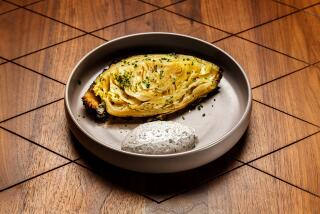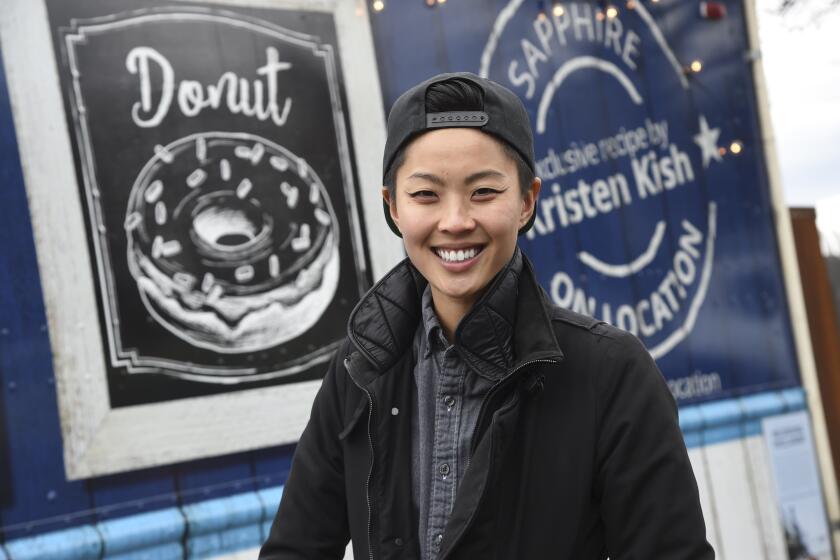Second-Generation Slaw
- Share via
When I was a kid and people asked me what my parents did, I would say, evasively, that they were both craftsmen, hoping I wouldn’t have to be more specific. If pushed further, I would have to admit that my father worked in wood, as a cabinetmaker, and my mother in ivory . . . as a dentist.
My mother graduated from dental school more than 50 years ago--she was the only woman in the school. She had been inspired by her Aunt Beck, the second member of the family to have come to America from Russia, who went on to become a dentist. But like most kids, I wanted to be like everyone else; I wanted to be able to say that my mother was at home.
Our family orientation was definitely oral. At 6, I could identify the sibilant sound of an older person wearing a plate, and my father rattled off Class A malocclusion diagnoses the way other fathers might refer to football players.
For obvious reasons, what we put into our mouths was considered of great consequence. Maybe the reason I hated to eat when I was growing up was that everything had to be healthy. But that’s what comes of having a mother who was a dentist and who was--liberation- and nutrition-wise--ahead of her time.
Four glasses of milk a day for me, to ensure strong bones and teeth; an apple a day (not to keep the doctor away but because it was “nature’s toothbrush”); no sodas, no sweets, no canned foods and no off-premise hot dogs (considered absolute poison). And when TV dinners were invented, they weren’t even discussed. In fact, TV itself was proclaimed bad for the eyes.
There were, however, a few exceptions to my reluctance to eat healthy foods, the main one being our family’s special version of coleslaw, invented by my grandmother, who lived with us and did the cooking. Rather than the usual creamy dressing, it was prepared with equal parts freshly squeezed lemon juice and oil. My mother’s much-appreciated recent additions are currants for little bursts of sweetness and chopped avocado, which adds a slight creaminess and lusciousness of flavor.
Years ago I bought my mother a food processor to help speed the shredding of the cabbage and the carrots. She tried it several times, but we all agreed that the hand-shredding added something to the texture. She returned to the old way and I breathed a sigh of relief.
When I was a child, this coleslaw often accompanied family meals, and we all enjoyed it on top of buttered rye bread. Because it was such a family favorite, it always appeared (and still does) at all holiday dinners. Its savory freshness and lightness in the face of all the heavier food makes it an ideal side dish.
It wouldn’t be Thanksgiving, in fact, without the turkey, Cousin Sue’s apple pie and Mom’s coleslaw. Any leftover slaw is still delicious--though less crisp--the following day, but that’s the storage limit, once the dressing has been added.
DR. LILLIAN WAGER’S COLESLAW
3 cups shredded cabbage
1 1/2 cups shredded carrots
1/2 cup chopped green pepper
1/4 cup dried currants, optional
1/4 cup olive oil (preferably light, not strongly flavored)
1/4 cup lemon or lime juice
1 1/2 teaspoons minced garlic
1/2 cup diced peeled avocado, optional
Place cabbage, carrots, green pepper and currants in large bowl. Pour oil and lemon juice in glass measuring cup. Add garlic and mix lightly. Pour over cabbage mixture and toss to mix.
Add avocado and toss lightly. Cover tightly and refrigerate at least 1 hour before serving. Best eaten same day. Makes 6 servings.
Note: Vegetable mixture, except avocado, can be prepared several hours ahead.
More to Read
Eat your way across L.A.
Get our weekly Tasting Notes newsletter for reviews, news and more.
You may occasionally receive promotional content from the Los Angeles Times.










